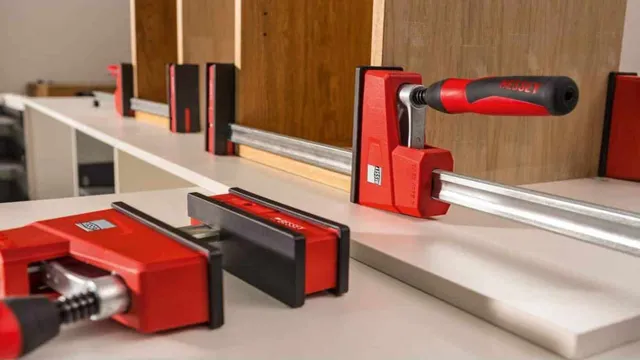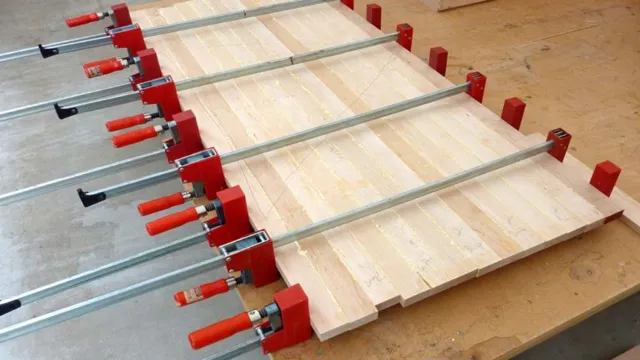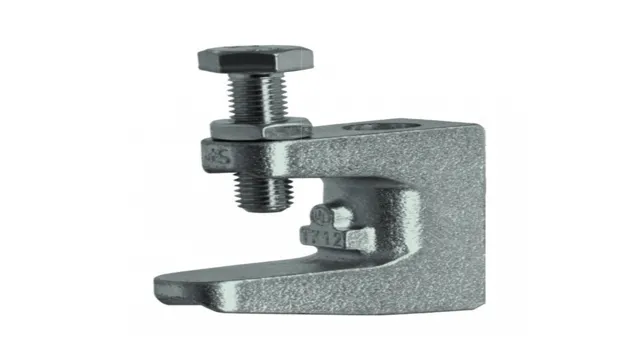Are Parallel Clamps Worth the Money? A Comprehensive Analysis to Help You Decide

As a woodworker, you know that having the right tools is essential to creating high-quality projects. One tool that’s been gaining popularity in recent years is the parallel clamp. But, are they worth the investment? Parallel clamps are known for their ability to apply pressure evenly, making them a go-to for woodworking enthusiasts.
But, with the cost of these clamps being higher than traditional ones, it’s important to weigh the pros and cons of investing in them. In this blog, we’ll explore the benefits of parallel clamps, how they differ from traditional clamps, and whether they’re worth the investment for your woodworking projects.
What are Parallel Clamps?
Parallel clamps are a type of woodworking clamp that provides a secure hold and even pressure across large surface areas. They are worth the money if you are someone who regularly engages in woodworking projects that require precise and heavy-duty clamping. Unlike traditional clamps, parallel clamps prevent distortion of your workpiece because each clamp jaw is in parallel and evenly spaced, ensuring that clamping force is distributed uniformly.
They also feature a comfortable handle that helps you maintain a strong grip while preventing hand fatigue. Investing in parallel clamps can prove to be a significant factor in the quality of your woodworking results. They offer unparalleled stability, high precision, and reliability, which, in turn, make your DIY or professional projects stand out from the rest.
So, if you’re looking to purchase clamps that offer quality and durability, then parallel clamps are a great choice.
Parallel Clamps vs Regular Clamps
Parallel Clamps Parallel clamps are a type of clamp that operates differently from regular clamps. Parallel clamps use a mechanism that keeps the jaws parallel to each other, as opposed to regular clamps that have one stationary jaw and one movable jaw. This means that parallel clamps can apply even pressure on the object being clamped, preventing it from warping or twisting.
Parallel clamps also have larger jaw openings than regular clamps, allowing them to clamp larger objects. In addition, parallel clamps have ergonomic handles that are easy to grip, making them comfortable to use for extended periods of time. Overall, if you need to clamp larger objects or want to prevent warping, parallel clamps are the way to go.

Benefits of Parallel Clamps
Parallel clamps are the unsung heroes of any woodworking or metalworking project. They are designed with the ability to distribute pressure evenly, which makes them ideal for clamping large and irregular shaped objects. These clamps come with jaws that can be adjusted in parallel to one another, hence the name.
They provide significant benefits over regular clamps, including stability, accuracy, and ease of use. One of the most significant benefits of parallel clamps is stability. They are designed with longer jaws, which means they can hold objects more securely than regular clamps.
This added stability means that there is less chance of your project moving around or slipping when pressure is exerted on it. Additionally, parallel clamps offer a greater amount of pressure, which makes them even more stable. Accuracy is another benefit provided by parallel clamps.
These clamps allow for more precise alignment, so you can adjust and work with greater accuracy. This is especially useful when working with delicate materials or when making precise cuts and shapes. Ease of use is also a significant advantage of parallel clamps.
These clamps are easy to use, and they hold the workpiece firmly in place without needing repeated adjustments. This means that you can save time and effort in setting up your work area and can focus on the creative side of your project instead. In conclusion, parallel clamps are an essential tool for any woodworking or metalworking project.
They offer stability, accuracy, and ease of use, making them an excellent investment for any craftsman. Whether you are a professional or a hobbyist, these clamps will make your work easier, faster, and more precise. So, if you are looking for high-quality clamps that will enhance your work, consider investing in parallel clamps.
Factors to Consider When Buying Parallel Clamps
When it comes to buying parallel clamps, it’s important to consider the quality of the material used, the clamp’s clamping force, and the size of the clamp. Although parallel clamps can be more expensive than conventional ones, their benefits often outweigh the cost. Their parallel jaws offer better stability and a more accurate alignment, making them ideal for tasks such as woodworking, cabinetry, and welding.
Parallel clamps can take on larger and thicker materials than their conventional counterparts while still applying an even pressure across the material. So, if you’re serious about your craft and need accuracy and stability, parallel clamps are worth the investment. Not only will they provide a high level of safety and precision, but they will also save you time and frustration in the long run by eliminating the need for excessive fidgeting and readjusting.
In conclusion, if you are a professional in need of high-quality, accurate, and sturdy clamps, parallel clamps are certainly worth the money.
Brand Reputation
When it comes to buying parallel clamps, there are a few important factors to consider to ensure that you get the best product for your needs. One of the most important considerations is the brand reputation of the clamp you are looking to buy. It’s important to research different brands and check out online reviews to see what other customers have to say about their experiences with the product.
Look for a brand that has a solid reputation for producing high-quality, durable clamps that can withstand heavy use over time. By investing in a reputable brand, you can be confident that you are getting a product that will work well and last a long time, which can save you money in the long run. So be sure to do your research and choose a parallel clamp brand that has a strong reputation in the market!
Clamping Capacity and Length
When it comes to buying parallel clamps, there are a few factors to consider, with clamping capacity and length being two of the most important. Clamping capacity determines how much pressure the clamp can exert, while length determines how big of an object can be clamped. You want to make sure the clamping capacity is appropriate for the type of material you’ll be working with.
If the clamps aren’t strong enough, they won’t keep the pieces held tightly together, and your project could shift during the gluing or clamping process. Additionally, the length of the clamp should be long enough to accommodate the object you’re working with, but not so long that it becomes unwieldy. It’s important to find a balance between the two, depending on your specific needs.
Overall, understanding clamping capacity and length will help you choose the right parallel clamps for your project, ensuring a successful outcome.
Clamping Pressure and Strength
When it comes to buying parallel clamps, there are several factors you should consider, such as clamping pressure and strength. The amount of pressure a clamp can apply is essential, as it determines how firmly the clamp can hold your workpiece in place without slipping or moving. Additionally, the strength of the clamp’s bar and jaw can affect its overall durability and longevity.
It’s important to choose a clamp that’s made from high-quality materials and has a robust design to ensure it can withstand frequent use and heavy stress. By taking these factors into account, you can find a parallel clamp that will provide the precision and stability you need for your woodworking projects.
Price and Value for Money
When shopping for parallel clamps, you want to make sure you get the best value for your money, but the price shouldn’t be the only factor to consider. First, you must look at the quality of the clamps and the materials used to make them. Cheap clamps may save you money upfront, but they may not last as long and could end up costing you more in the long run.
Also, take a look at the pressure rating of the clamps, which determines how much force they can exert. The higher the pressure rating, the stronger the clamp. Additionally, consider the size and length of the clamp, ensuring it’s suitable for the projects you’ll be working on.
Lastly, read reviews and seek recommendations from professionals or friends who also work with clamps. It’s always better to invest in quality clamps that will last longer and save you money in the long run, rather than continually replacing cheap ones.
Conclusion
In conclusion, asking if parallel clamps are worth the money is like asking if a good cup of coffee is worth the extra dollar. Sure, you could settle for an inferior product, but why settle when you can have a superior experience? Parallel clamps offer greater versatility, strength, and precision than traditional clamps, making them a worthwhile investment for any woodworking enthusiast. So, to answer the question, parallel clamps are definitely worth the money – your projects (and your coffee) will thank you for it.
“
Parallel Clamps vs Other Clamps
When it comes to woodworking or any carpentry project, clamping is an essential part of the process. But with endless clamp options available in the market, it can be challenging to choose the perfect one that suits your needs. When deciding on whether to use parallel clamps or other types of clamps, it’s essential to consider a few factors.
The length of the jaw is a significant consideration. Parallel clamps are ideal for wider boards since they have longer jaws than other clamps, enabling you to apply even and consistent pressure across the entire length of the board. Additionally, parallel clamps have a higher clamping force, which ensures that your workpiece stays in place even under heavy pressure.
Another critical factor is the ease of use. Parallel clamps are user-friendly, comfortable to use, and can be adjusted with one hand. Other types of clamps may require two hands and more adjustments to achieve the same level of clamping force.
Overall, parallel clamps are the perfect choice for anyone looking for a reliable and user-friendly clamp for their woodworking projects.
Verdict: When are Parallel Clamps Worth the Investment?
Parallel Clamps Parallel clamps are a valuable tool for any woodworker, but when are they worth the investment? First and foremost, it depends on the types of projects you plan to work on. If you primarily work on smaller projects, parallel clamps may not be necessary. However, if you plan to work on larger, more complex projects or need to clamp multiple pieces at once, parallel clamps are definitely worth the investment.
Another factor to consider when buying parallel clamps is the quality of the clamps themselves. Low-quality clamps may not provide the necessary pressure or stability needed for certain projects, so investing in a higher quality set of parallel clamps is a must. Finally, it is a good idea to consider the cost of the clamps.
While high-quality parallel clamps can be expensive, they are often worth the investment over time due to their longevity and efficiency in completing projects. In summary, if the projects you plan to work on require the use of parallel clamps and high-quality clamps are within your budget, then investing in a set of parallel clamps is definitely worth it.
FAQs
What are parallel clamps used for?
Parallel clamps are used for securing and holding together long or wide pieces of wood or other materials with even strength and pressure.
What are the advantages of using parallel clamps over other types of clamps?
Parallel clamps provide more even pressure distribution, greater clamping force, and more stable clamping than other types of clamps. They also enable one-handed operation and can be used for a variety of woodworking projects.
How do I choose the right size parallel clamp for my project?
To choose the right size parallel clamp, measure the width of the material you want to clamp and add an additional 4-6 inches to the length of the clamp. This will ensure that you have enough clamping capacity and can achieve even pressure across the entire surface.
Are parallel clamps worth the investment?
Yes, parallel clamps are worth the investment for serious woodworkers and hobbyists who want to achieve professional-level results. They offer superior clamping performance and are durable enough to last for years of use.
What should I look for when purchasing parallel clamps?
When purchasing parallel clamps, look for well-made clamps with a solid, stable body and jaw. Check for smooth sliding action and easy one-handed operation. Also, consider the clamping force and size capacity to ensure they meet your project needs.
Can parallel clamps be used for metalworking projects?
Yes, parallel clamps can be used for metalworking projects as long as the material being clamped is not too thick or heavy for the clamp. They are particularly useful for clamping metal tubing or long flat pieces.
How do I maintain and care for my parallel clamps?
To maintain and care for your parallel clamps, clean them after each use and store them in a dry location. Lubricate the threads and moving parts occasionally to ensure smooth operation. Check for any damage or wear and replace any damaged parts promptly.



